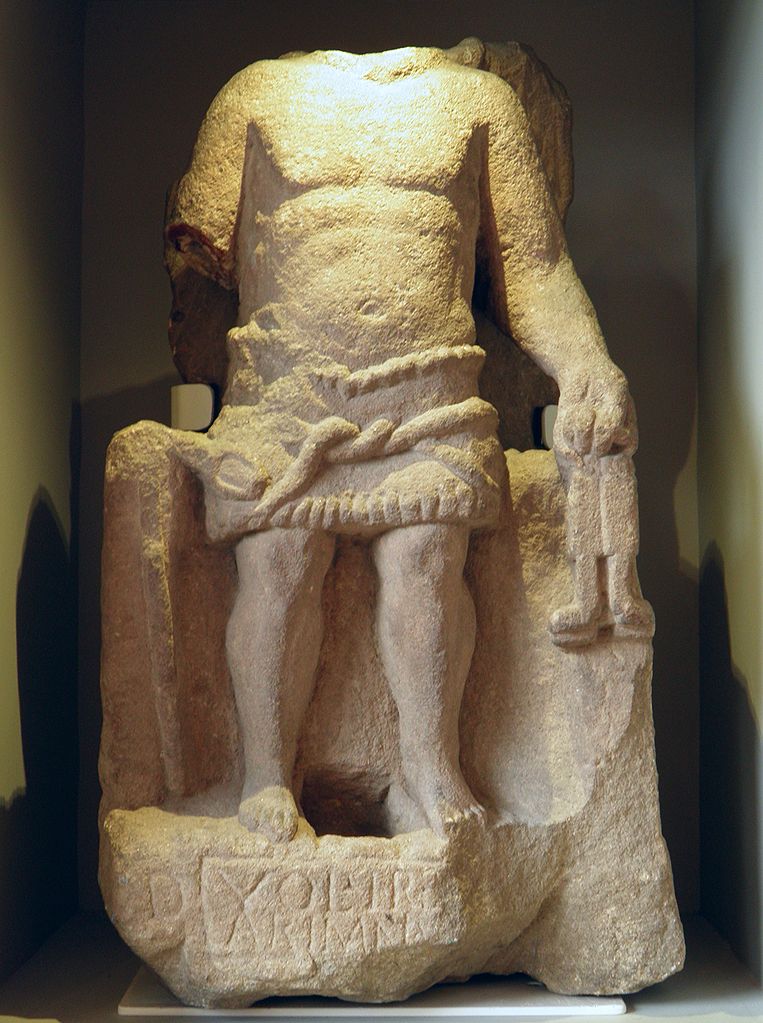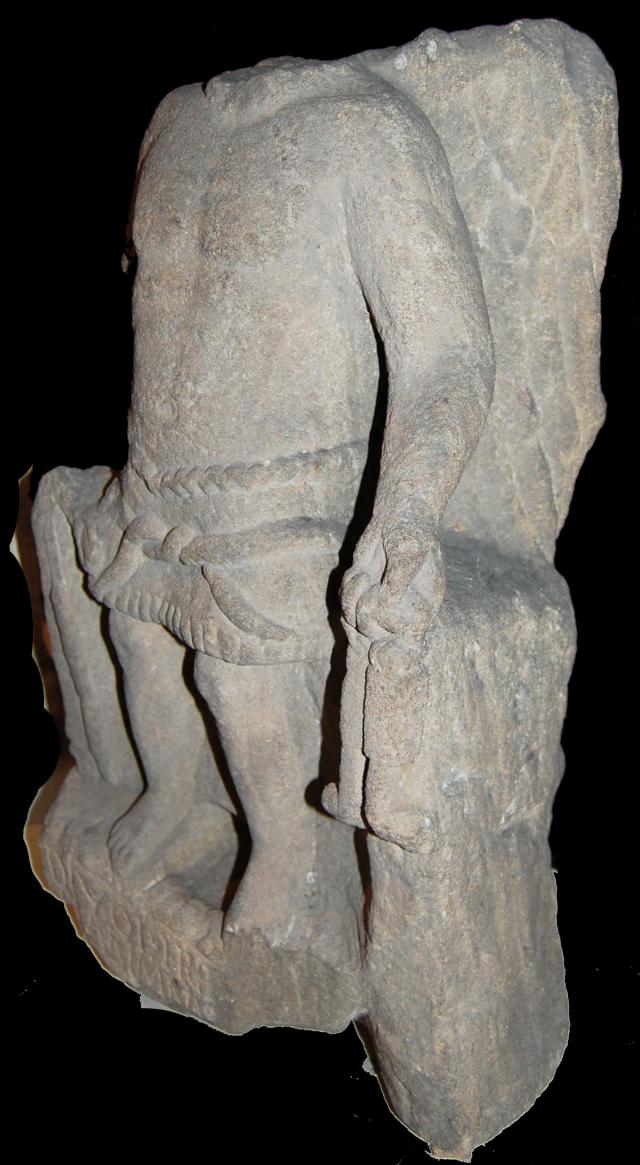
CIMRM 833-834 - Arimanius / Lion-headed statue from York. (RIB 641)
Described by Steedman as follows:2
The head and part of the right arm, just above the elbow, of the statue are missing. The stump of the right arm has a hole in the middle, which contains some residue (possibly glue from the modern era). The left arm is slightly bent, and the hand holds a ring from which hang two keys. The ring is gripped between the fingers and the thumb. The upper torso is bare, with sculpted pecs, abs and belly button. The statue wears a fringed skirt, with a rope-style belt (some of which has been eroded) around the waist. The knees show beneath the skirt; the legs and feet are bare. Toe detail is still visible on the right foot. The head of a snake sits just above the right knee, but no detail of its face has been preserved. Next to the right leg is the shaft of an implement which may have been a spear held by the right hand. The statue has wings on both sides, which start at the top of the shoulders; the top of the right wing is missing. The bottom and lower half of the back of the statue have been roughly hewn; the top half of the back is taken up by the wings. A bowl (or small well) has been carved out between the feet, which may have been used for liquid offerings.
Beck adds:3
A final British monument which has always received a fair amount of attention is the York "Aion" (833), for its dedicatory inscription (834) bears the tantalising word Arimani, opening the possibility that the Mithraic "Aion" or lion-headed god is a descendant, if only in name, of the Iranian Ahriman, the power of evil. The other alternative is that it is the dedicant who is Arimanius. Both statue and inscription have recently been scrutinised by J. R. Hinnells (1975c: 340-343) and U. Bianchi (1975: 460-462; see also Gordon 1975: 221f. with n.25). Hinnells, who does not rule out Arimanius as dedicant, points out that even if it is the god who is Arimanius, he may well not be Mithraic. He was not found in association with other Mithraic objects and, contrary to certain descriptions, there are no traces of the lion's mane on the headless neck and his belt is not serpentine. Iconographically, then, he is only very tenuously linked with the Mithraic lion-headed god. Bianchi, who concentrates on the inscription, argues for an accusative Arimani[um (cf. 222, the Ostian dedication of a signum Arimanium), signifying the god's statue dedicated by the subject Vol(usius) Ire(naeus) (other readings suggest dative Arimani[o as the god to whom the dedication is made; see Harris and Harris p.43). Scepticism and caution in the use of this monument as evidence about the Mithraic lion-headed are probably now the best policy.
CIMRM entry.
833. Statue in sandstone (H. 0.61), found in York (1875). Yorkshire, Philosophical Society. Hübner in Jahrbuch des Vereins von Altertumsfreunden im Rheinlande4 LVIII, 1876, 147ff and Pl. VIII, 1 (Online here); MMM II 392 No. 271 and fig. 310.
On a base a standing, naked figure, dressed in a fringed loin-cloth, which is held together by a snakelike belt. In his hanging l.h. two keys, whereas the other, which is broken off as far as the elbow, must have held a sceptre, part of which is still visible on the edge of the stone, together with an undefinable object (thunderbolt?), half of which is preserved on the fringes. To his shoulders two wings are attached. Head lost. On the base, in a tabula ansata, an inscription:
834.
MMM II No. 474.
D(eo) ... / Vol(usii) Ire[naeus,et] / Arimaniu[s posuerunt].
Text.
D[EO] VOL(USIUS)ΔIRƎ
ARIMANI V(OTUM)
- possibly followed by SLMDD (solvens libens mento dono dedit)
In Line 1 the end of the "Ǝ" is worn away.
In Line 2 the "M" has a ligature making it "MA", and the "N" has a ligature making it "NI". In the last letter, only the start of the V is visible.
Translation: "Volusius Ireneaus to the god Arimanes a gift (willingly and deservedly fulfilling his vow)".5
Literature.
- John R. Hinnells, Mithraic Studies vol. 1, p. 460. This tells us that the York inscription to Arimanius is TMMM vol. 2, p. 392, mon. no. 271, fig. 310, inscription no. 474. = CIMRM 833 f. Published with plate by L. Hübner, 'Denkmäler des Aeon', Jahrbücher des Vereins von Alterthumsfreunden im Rheinlande (contd. as Bonner Jahrbücher), LVIII, 1876, p. 147-54, plate VIII, 1. Apparently there is an explicit differentiation where the Modena Mithras-Phanes is concerned (n.23).
- More may be found here. Found in 1875. Inscription "Volusius Irenaeus Arimanio votum solvit" according to Legge - but Bianchi has a different view.
- CIMRM 833 = RIB 641 (from York); three dedications to Arimanius: CIMRM 222 (from Ostia); 369 (from Rome); 1773 and 1775 (from Carnuntum).
- RIB641: RIB641. "A headless statue with a partially preserved inscription below. The statue was found in 1874 under the city wall of York during the construction of the New [i.e. present] Railway Station. The statue is currently in the Yorkshire Museum." Has details of the item.
- R.L.Gordon, "Cumont and the doctrines of Mithraism," in: Hinnells Mithraic Studies vol.1, p.221, n.25.
| 1 | See also Bonner Jahrbücher. |
| 2 | Marjon Steedman, Workshop II: York 2008. Report on RIB 641. |
| 3 | R. Beck, "Mithraism since Franz Cumont", ANRW, p.2034-5 |
| 4 | See also Bonner Jahrbücher. |
| 5 | This material from Steedman. |
| Tweet |






